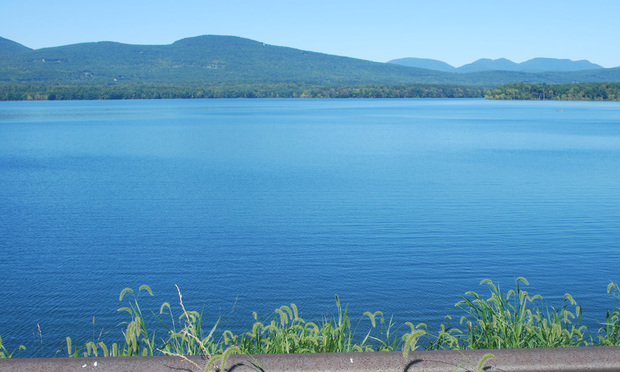Environmental Law: On the Supreme Court's Docket for 2020
Two cases are on the New Jersey Supreme Court's docket that are of particular interest to environmental and land use attorneys.
January 10, 2020 at 12:30 PM
7 minute read
 Julian Colton/Wiki
Julian Colton/Wiki
Two cases are on the New Jersey Supreme Court's docket that are of particular interest to environmental and land use attorneys.
The first involves the construction of two high-rise residential buildings on the Hudson River waterfront. Shipyard Associates L.P. v. City of Hoboken, 2019 WL 149532 (App. Div.), certif. granted, 238 N.J. 150 (2019). For a discussion of how recently approved legislation will affect future waterfront development, see L. Goldshore, "Public Trust Doctrine Legislation," 225 N.J.L.J. 1198 (May 13, 2019).
The second concerns the allocation of the financial burden for repair and rehabilitating a failing private dam. Crispino v. Township of Sparta, 2019 WL 1986540 (App. Div.), certif. granted, 239 N.J. 600 (2019). See, L. Goldshore, "Construing Dam and Reservoir Responsibilities in NJ," 219 N.J.L.J. 163 (Jan. 19, 2015), for a review of how the Safe Dam Act, N.J.S.A. 58:4-1 et seq., addressed cost-sharing among owners or persons "having control of a reservoir or dam …." N.J.S.A. 58:4-5.
Hudson River Waterfront Development
The Supreme Court has agreed to hear the latest case in a long running battle between objectors—including existing residents, a nonprofit organization dedicated to securing a waterfront park along the Hudson River, and the City of Hoboken (the City)—and a developer (Shipyard Associates) that is engaged in completing the construction of a large residential development along the waterfront. Reduced to its essence, the case is about alleged loss of views and recreation opportunities due to the replacement of previously approved tennis courts with two 11-story high-rise residential buildings on a Hudson River pier. Shipyard Associates v. City of Hoboken, 2019 WL 149532 (App. Div.), certif. granted, 238 N.J. 377 (2019) (Shipyard III).
Shipyard I involved an unsuccessful challenge by the objectors to a DEP waterfront-development permit issued to the developer. In re Shipyard Assocs. L.P. Waterfront Dev. Permit, Do. No. A-4873-13, certif. denied, 230 N.J. 397 (2017). Shipyard II addressed the Municipal Land Use Law's (MLUL), N.J.S.A. 40:55D-1 et seq., automatic approval provision that is triggered when a planning board fails to grant or deny a completed application within 120 days of submission, as required by N.J.S.A. 40:55D-61. In Shipyard Assocs. L.P. v. Hoboken Planning Bd., Do. No. A-4504-14, certif. denied, 232 N.J. 106 (2018), the Appellate Division made it clear that "[i]f there is a lesson to be learned from this case, it is that the rule of law is paramount and cannot be sidestepped to avoid deciding unpopular land use applications."
During the pendency of Shipyard I and II, the City took a different tack and adopted zoning and flood control ordinances that prohibited construction of buildings, other than low-rise recreational structures, on waterfront piers. The trial judge noted that the federal and state agencies that reviewed the project had not identified any safety concerns; additionally, the project complied with DEP criteria for building a structure on a pier or platform.
The Appellate Division agreed with the trial court but cautioned that it was not ruling that a zoning ordinance affecting health and safety could never be applied to modify a previously-granted final approval. In this instance the objectors were not seeking to simply tweak or modify the "general terms and conditions" of a preliminary approval as authorized by N.J.S.A. 40:55D-49(a). Rather, what the City attempted to do here was to retroactively and impermissibly apply ordinances that completely changed the permitted uses in the zone and revoke a previously-granted final site plan approval contrary to the plain wording of N.J.S.A. 40:55D-52(a).
Environmental and land use practitioners will be especially interested in what weight, if any, the Supreme Court accords to health and safety/environmental concerns in a MLUL automatic approval setting. Because of the development's proximity to the Hudson River, the recently enacted Public Trust Doctrine Law may provide an unexpected and unanticipated factor in that analysis. N.J.S.A. 13:1D-150 et seq.
Who Pays to Repair Failing Dams and Reservoirs?
There are approximately 1,700 dams and reservoirs in New Jersey. Due to deferred maintenance, many of these structures are in need of repair and rehabilitation. Because the remedial costs tend to be substantial, disagreements concerning the identity of the responsible parties and the apportionment of the financial burdens are inevitable. One such controversy that the Supreme Court will consider later this year involves the Glen Lake Dam (the Dam) in Sparta Township (the Township), Sussex County.
The Dam, owned by the Glen Lake Beach Club, Inc. (the Club), created a private recreational lake for the adjacent property owners' use and enjoyment. Two classes of membership—voting and non-voting—were established, depending on proximity of the property to the lake. That disparate treatment would set the stage for future interclass disputes.
The need to upgrade the Dam can be traced to the August 11-14, 2000, flood when more than 14 inches of rain fell in southeastern Sussex County, resulting in a federal disaster area declaration. That event was followed by DEP's ordering that the Dam be repaired and rehabilitated to comply with state regulatory requirements.
It was not until 2008 that the Club applied for a loan from the DEP's Dam Restoration and Inland Waters Projects Loan Program to finance the needed improvements. See N.J.A.C. 7:24A-1.1 et seq. As required, the Township cosigned the application, and repayment would be by way of special assessments on the benefitted properties. See Dam, Lake and Stream Project Fund, N.J.S.A. 58:4-12; 40:56-21 et seq., authorizing assessments for local improvements.
Following the loan's approval, the seldom easy next steps included formulating the assessment methodology and recouping the project's costs from the various property owners. The Township appointed a consultant who issued a report that identified three classes of specially benefited properties: basic membership lots were assigned a share value of 1.0; lake access lots, a share value of 1.5; and lakefront lots, a share value of 2.0
In 2016, the Township adopted the special assessment that implemented the consultant's recommendations. But the trial court ruled that the formula was based on a net opinion and held that it was arbitrary because it depended on eligibility for Club membership.
The Appellate Division disagreed, finding that the net opinion rule was inapplicable in this non-judicial setting and, even if it applied, the expert report included the "why" and "wherefore" for the methodology. The appeals court concluded that the "opinion was not a net opinion" and that the Township's action "was neither arbitrary nor unreasonable but was just and fair."
The Supreme Court's decision will address the admissibility of the report and responsibility for the Dam's repair and rehabilitation costs. While the ruling should provide guidance for other similar projects, due to the substantial costs involved disputes are likely to continue to arise concerning the identity of the responsible parties and how the financial burdens should be shared.
Lewis Goldshore practices in Princeton. His practice is devoted to environmental, land use and municipal law. He is the author of New Jersey Environmental Law (ICLE 2010).
This content has been archived. It is available through our partners, LexisNexis® and Bloomberg Law.
To view this content, please continue to their sites.
Not a Lexis Subscriber?
Subscribe Now
Not a Bloomberg Law Subscriber?
Subscribe Now
NOT FOR REPRINT
© 2025 ALM Global, LLC, All Rights Reserved. Request academic re-use from www.copyright.com. All other uses, submit a request to [email protected]. For more information visit Asset & Logo Licensing.
You Might Like
View All
Social Media Policy for Judges Provides Guidance in a Changing World
3 minute read
Bank of America's Cash Sweep Program Attracts New Legal Fire in Class Action
3 minute read
'Something Really Bad Happened': J&J's Talc Bankruptcy Vote Under Attack
7 minute readTrending Stories
- 1Family Court 2024 Roundup: Part I
- 2In-House Lawyers Are Focused on Employment and Cybersecurity Disputes, But Looking Out for Conflict Over AI
- 3A Simple 'Trial Lawyer' Goes to the Supreme Court
- 4Clifford Chance Adds Skadden Rainmaker in London
- 5Latham, Kirkland and Paul Weiss Climb UK M&A Rankings
Who Got The Work
J. Brugh Lower of Gibbons has entered an appearance for industrial equipment supplier Devco Corporation in a pending trademark infringement lawsuit. The suit, accusing the defendant of selling knock-off Graco products, was filed Dec. 18 in New Jersey District Court by Rivkin Radler on behalf of Graco Inc. and Graco Minnesota. The case, assigned to U.S. District Judge Zahid N. Quraishi, is 3:24-cv-11294, Graco Inc. et al v. Devco Corporation.
Who Got The Work
Rebecca Maller-Stein and Kent A. Yalowitz of Arnold & Porter Kaye Scholer have entered their appearances for Hanaco Venture Capital and its executives, Lior Prosor and David Frankel, in a pending securities lawsuit. The action, filed on Dec. 24 in New York Southern District Court by Zell, Aron & Co. on behalf of Goldeneye Advisors, accuses the defendants of negligently and fraudulently managing the plaintiff's $1 million investment. The case, assigned to U.S. District Judge Vernon S. Broderick, is 1:24-cv-09918, Goldeneye Advisors, LLC v. Hanaco Venture Capital, Ltd. et al.
Who Got The Work
Attorneys from A&O Shearman has stepped in as defense counsel for Toronto-Dominion Bank and other defendants in a pending securities class action. The suit, filed Dec. 11 in New York Southern District Court by Bleichmar Fonti & Auld, accuses the defendants of concealing the bank's 'pervasive' deficiencies in regards to its compliance with the Bank Secrecy Act and the quality of its anti-money laundering controls. The case, assigned to U.S. District Judge Arun Subramanian, is 1:24-cv-09445, Gonzalez v. The Toronto-Dominion Bank et al.
Who Got The Work
Crown Castle International, a Pennsylvania company providing shared communications infrastructure, has turned to Luke D. Wolf of Gordon Rees Scully Mansukhani to fend off a pending breach-of-contract lawsuit. The court action, filed Nov. 25 in Michigan Eastern District Court by Hooper Hathaway PC on behalf of The Town Residences LLC, accuses Crown Castle of failing to transfer approximately $30,000 in utility payments from T-Mobile in breach of a roof-top lease and assignment agreement. The case, assigned to U.S. District Judge Susan K. Declercq, is 2:24-cv-13131, The Town Residences LLC v. T-Mobile US, Inc. et al.
Who Got The Work
Wilfred P. Coronato and Daniel M. Schwartz of McCarter & English have stepped in as defense counsel to Electrolux Home Products Inc. in a pending product liability lawsuit. The court action, filed Nov. 26 in New York Eastern District Court by Poulos Lopiccolo PC and Nagel Rice LLP on behalf of David Stern, alleges that the defendant's refrigerators’ drawers and shelving repeatedly break and fall apart within months after purchase. The case, assigned to U.S. District Judge Joan M. Azrack, is 2:24-cv-08204, Stern v. Electrolux Home Products, Inc.
Featured Firms
Law Offices of Gary Martin Hays & Associates, P.C.
(470) 294-1674
Law Offices of Mark E. Salomone
(857) 444-6468
Smith & Hassler
(713) 739-1250







